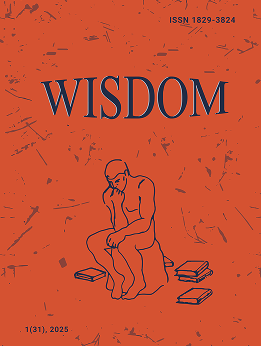Camus’ Understanding of the Paradoxically Multidimensional Human Being
DOI:
https://doi.org/10.24234/wisdom.v3i2.866Keywords:
self-overcoming, self-recognition, the meaning of life, paradox, dual nature, human being, truth, despair, multidimensionality, anthropologicalAbstract
The article analyses important issues of philosophical anthropology from a socio-philosophical viewpoint. By defining a human being in different stages of the development of philosophical thought, one or another of his genus’s essential characteristics are distinguished. Modern philosophy documents that human beings are paradoxical, contradictory beings and subject to complicated definitions. This analysis is based on the different approaches of well-known researchers, leaning on the human paradox and trying to rationalise it as much as possible. The article combines the main approaches that provide an opportunity to justify humans’ philosophical essence and nature comprehensively.
Downloads
References
Abrahamyan, L-?. (1995). Lekcii po filosofii (Philosophy lectures, in Russian). Yerevan: Nairi.
Tuffuor, A. N., & Payne, R. (2017). Isolation and suffering related to serious and terminal illness: Metaphors and lessons from Albert Camus’ novel “The Plague”. Journal of Pain and Symp-tom Management, 54(3), 400-403.
Apresyan, R. (2019). Universalizacia moralnikh sujdeniy (osnovania i proektsii) (Universalisation of moral judgments (bases and projections), in Russian). Philosophy Journal, 12(3), 110-125.
Barseghyan, H. (2022a). Question pursuit as an epistemic stance. Studies in History and Philosophy of Science, 94, 112-120.
Barseghyan, H. (2022b). Selection, presentism, and pluralist history. Studies in History and Philoso-phy of Science, 92, 60-70.
Camus, A. (1955). The myth of Sisyphus and other essays. (J. O’Brien, Trans.). London: Hamish Hamilton.
Camus, A. (1995). Resistance, rebellion, and death, vintage. The New York City: Vintage Interna-tional.
Camus, A. (2012). The outsider. London: Penguin.
Camus, A. (2021). The Plague. New York: Knopf.
Camus, A. (1956). The fall. New York: Vintage Books.
Diogenes, L. (1986). O jizni, ucheniakh I izrecheniakh znamenitikh philosophov (Live of eminent phi-losophers, in Russian). Moscow: “Misl”.
Huizinga, J. (1949). Homo Ludens: A study of the play-element in culture. London, Boston and Hen-ley: Routledge & Kegan Paul.
Karavournioti, A. (2020). Albert Camus absurd of human life. Paper presented at the Conference Albert Camus “The absurd of human life and the man named Sysiphus”. Retrieved from https://www.researchgate.net/publication/345390212_Albert_Camus_The_Absurd_of_Human_Life
Lebedev, S. A., & Lazarev, F. V. (2010). Mnogomerniy chelovek: Ontologia i metodologia isledovania (Multi-dimensional human: Onthology and methodology research, in Russian). Moscow: University Publishing.
Marcuse, H.(1964). One-dimensional man. Boston: Beacon Publisher.
Scheler, M. (1988). Polojenie cheloveka v kosmose (The human place in the cosmos, in Russian). Moscow: “Progress”.
Shakaryan, H. (2005). Pilisopayutyun: usumnakan dzernark (Philosophy: Students book, in Armenian). Yerevan: YSU Publication.
Stepanyan, A., Manukyan, Y., Tevosyan, L., & Iliushina, M. (2022). Legal regime for scientific works in the digital age. WISDOM, 21(1), 117-122. https://doi.org/10.24231/wisdom.v21i1.625
Downloads
Published
How to Cite
Issue
Section
Categories
License
Copyright (c) 2022 scientific journal WISDOM

This work is licensed under a Creative Commons Attribution-NoDerivatives 4.0 International License.
Creative Commons Attribution-Non-Commercial (CC BY-NC). CC BY-NC allows users to copy and distribute the article, provided this is not done for commercial purposes. The users may adapt – remix, transform, and build upon the material giving appropriate credit, and providing a link to the license. The full details of the license are available at https://creativecommons.org/licenses/by-nc/4.0/.















